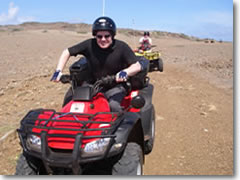Westpunt—Curaçao's wild side
Adventures on Curaçao's Westpunt, or West End—ATV tours of the Boca Tabla, jeep safaris in Mt. Cristoffel National Park, and sampling the local cuisine.

Mmmm, a big steaming plate of curied iguana, Curaçao's answer to Viagra. (Photo by Reid Bramblett) The roadside eatery called Jaanchies (011-5999-864-0126) has been famous on Curaçao since 1936 for its cheap, heaping tin platters of shrimp, baked wahoo, dirty rice with beans and plantains, and fried potatoes, its twittering clouds of tiny Venezuelan troupials (commonly called "yellow-bellied sugar thieves"), and its side dishes of curried goat and iguana.
"Do you have a girlfriend on the island?" Jaanchie asked as I bit into a breast (like chicken, but bonier). "You better have a girl, because iguana will make a fire in your belly tonight!" He laughed and slapped me on the shoulder. (Since iguanas are, ahem, doubly endowed, they are considered a potent aphrodisiac.)
Four-Wheeling in the Caribbean
Jaanchies is in Westpunt , the wild, western end of this arid and mountainous island. Before indulging in the iguana, I spent the morning on an ATV tour around the flatlands of Westpunt's Boca Tabla with Eric, a Curçaoleno with a Colgate smile (011-5999-524-7418, www.curacao-atv.com, $90 for a half-day).

Taking on the wilds of Westpunt on an ATV tour of Curaçao. After muscling my Honda up rocky gullies, dodging waby bushes with their two-inch thorns, and passing seaside blowholes that, were they alongside a paved road anywhere else, would be marked as tourist attractions, we stopped at Shete Boca National Park (www.carmabi.org) to learn more about the island's volcanic history and the green, hawksbill, loggerhead, and leatherback sea turtles that nest in the area's nearly inaccessible scraps of beaches.
My main question about the natural side of Curaçao was why the primary message from the scrubby vegetation was: "Stay the !@#$% away!" Everything seemed to be either a cactus or a waby bush bristling with two-inch spines. Eric had wanred us to be a bit careful gunning the ATVs, since you can go out of control pretty easily; didn't stop one member of the group I was in from driving straight into a waby bush.
Eric told him not to feel so bad. A few months earlier he had a headstrong client who refused to listen to the instructions abut taking it nice and slow when going down then back up the steep slopes of a wash gully. Instead, the guest gunned the engine on the uphill, ended up rearing back on the hind wheels, and dumped his girlfriend, who was riding on the back, uncermoniously to the ground. The fact that the couple in question was Tom Cruise and Katie Holmes made the story that much funnier.
A Caribbean Mountain Safari
After lunch, picking bits of iguana from my teeth, I hopped aboard a yellow Land Rover for an afternoon Yellow Jeep Safari (011-5999-462-6262, www.tourism-curacao.com, $64 half-day, $94 full day). We jounced down the dirt roads of Mt. Cristoffel Park (www.carmabi.org), visiting 300-year-old plantation ruins, hiking to sweeping island views, and learning even mroe in depth the many interesting ways in which Curaçaoan plants can injure you.

A snail seeks shelter behind the thorns of a kadushi cactus in Curaçao's Mt. Christoffel Park (Photo by Reid Bramblett)Again, anything that wasn't some form of cactus seemed to be a spiny waby bush, or a rubber vine lashing out with whip-like tendrils, or a manzanila tree dangling a poisonous, apple-like fruit. The closest any plant came to cuddly was the filo de diable, or "devil's thread," a sickly yellow, parasitic vine that entwines itself around everything.
According to our guide Steven Adamus—avid surfer and diver, part-time model, self-taught botanist, and former Mr. Curaçao—local girls find out if a boy likes them by draping a piece of Devil's Thread over a cactus in his yard. If the vine takes hold, that's the boy you'll marry—though the metaphor of strangling his cactus with your vine calls into question the Curçaoan concept of a healthy marriage.
Diving the Blue Room

A school of rumbellies lets snorkelers swim alongside in Curaçao's Blue Room sea cavern. (Photo by Reid Bramblett.)Most folks travel to this part of the Southern Caribbean for one thing: getting underwater. So, before my afternoon flight home, I donned snorkel gear to grab a glimpse of underwater Curaçao at the
Blue Room.
I swam past swarms of blue tang, frilly squid, peacock flounder, queen angelfish, and iridescent parrotfish right up to the coral cliff--then right under it, bumping my snorkel against the low rock.
Ten feet in, the ceiling expanded into a sea cavern populated by stingless jellyfish and huge schools of rumbellies. The sunlight from outside reflected off the sandy bottom to create an eerie turquoise glow as intense as a bottle of Blue Curaçao liqueur.
Every resort and hotel on Curaçao has a dive boat partner offering scuba and snorkel trips. I visited the Blue Room with Ocean Encounters West (011-5999-461-8131, www.oceanencounters.com), managed at Kura Hulanda Lodge by a Chicago native and her Arizona-born husband.
Related Articles |
|
This article was by Reid Bramblett and last updated in December 2011.
All information was accurate at the time.
Copyright © 1998–2013 by Reid Bramblett. Author: Reid Bramblett.
